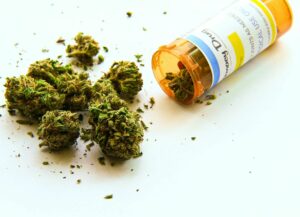While medical researchers have identified more than 480 components in
cannabis,
including 66 compounds unique to the plant, scientists have yet to
determine exactly how these chemical components work together to produce
different reactions. One concept, termed the "entourage effect,"
theorizes that some cannabis compounds, which have no effect in
isolation, affect the human body only when combined with other
components.
Synergy vs. the Entourage Effect
Before the entourage effect gained prominence in medical circles, many
researchers discussed the effect of
synergy
in herbal medicines and dietary supplements. For components within an
herbal medicine to achieve synergy, the effects of two or more
components must become magnified when combined. Synergisms also explain
why vitamins in isolation are less beneficial than eating fruits and
vegetables that contain a wide variety of vitamins and antioxidants.
The entourage effect is a related, but different, concept. For the
entourage effect to occur, isolated components must have no noticeable
benefit in curing the condition under examination. However, when
combined with other components that also have no discernible benefit,
there must be a palpable advantage to using the composite.
Researchers believe that the entourage effect explains why cannabis can
be so effective when treating certain conditions while synthetic
formulations of only THC or CBD medications may only achieve limited
success in some patients. Evidence suggests that although certain
cannabinoids may appear to be inert, they may produce tangible benefits
when mixed with other compounds.
How the Entourage Effect Impacts Medication Formulation
When patients reported that cannabis consumption eased the weight loss
caused by AIDS or the adverse affects of chemotherapy, medical
researchers analyzed the plant to determine what caused these benefits.
Research credited the cannabinoid THC for these benefits, so
pharmaceutical companies isolated the THC to create drugs to address
AIDs and chemotherapy symptoms. However, patients who used these
THC-only
drugs
reported greater psychotropic side effects when compared to ingesting
cannabis.
Further research into cannabis uncovered that the cannabinoid CBD,
blended with other cannabinoids, reduced the hallucinatory effects of
THC. Therefore, THC-only drugs eliminated the benefit of the rest of the
cannabinoids. The Israeli chemist Raphael Mechoulam named this observed
phenomenon the entourage effect.
Pharmaceutical companies used the concept of the entourage effect to
reformulate their THC-only medications to include an equal measurement
of CBD. The resulting formulations achieved a greater therapeutic
benefit while reducing the adverse reactions of THC-only medications.
The entourage effect also impacts the work of scientists who want to
breed certain strains of
cannabis
to treat specific health problems. Breeding these cannabis strains to
increase specific cannabinoids that may treat common ailments may result
in new plants that can better treat patients with fewer side effects.
However, such new strains also may create an imbalance within the
different cannabis compounds that eliminate known benefits.
Whole Plant Medicinal Use: Barriers and Origins
For people who have observed or experienced the entourage effect in
cannabis, it may be difficult to understand why some doctors hesitate to
recommend botanical cannabis use and prefer medications with only THC or
CBD cannabinoids. Many medical professionals prefer to prescribe a
single compound used to treat a specific problem, disease or ailment
because Western medical philosophy endorses this type of
isolated-treatment medicine. While this approach may unintentionally
eliminate the entourage effect of cannabis, doctors support this
philosophy because it also serves to minimize adverse side effects.
However, to effectively use botanical cannabis, some researchers argue
that doctors should reject the idea of creating a single potent drug to
treat an isolated problem. Instead, these researchers believe that
doctors should return to a philosophy of treating multiple possible
problems with a low dosage of a single, wide-range medication. These
scientists, including noted cannabis researcher Vincenzo Di Marzo, also
believe that some cancers and other diseases may come from an imbalance
of some natural
systems
within the human body.
This concept of poly-pharmacology remains in practice in traditional
Chinese medicine. Instead of using a single herb to treat a specific
problem, practitioners prescribe a combination of herbs called herbal
formulas. The combinations of these herbs, some of which may have no
discernible benefit on their own, are well-known to have many benefits
from numerous past studies. Experts carefully combine the herbs to
create the necessary treatment for a combination of related health
problems.
Known Instances of the Entourage Effect in Cannabis
While the effect of CBD on THC is the most notable illustration of the
entourage effect, research also indicates that cannabinoids and
terpenes may also
combine
to achieve greater therapeutic advantages. Studies indicate that certain
terpenes may impact the blood-brain barrier, which may explain why
certain cannabinoids have greater efficacy when they do not operate in
isolation.
In the whole-plant cannabis versus synthetic-cannabis medication debate,
all researchers agree that the entourage effect is still not a concept
that they fully understand. Further research into exactly how THC, CBD
and other important cannabis compounds work will allow scientists to
make better recommendations for how to use cannabis compounds to treat
various diseases and ailments. With nearly 500 different cannabis
components to explore, the field of whole-plant and
synthetic-cannabinoid medications is wide open for new and exciting
developments.






